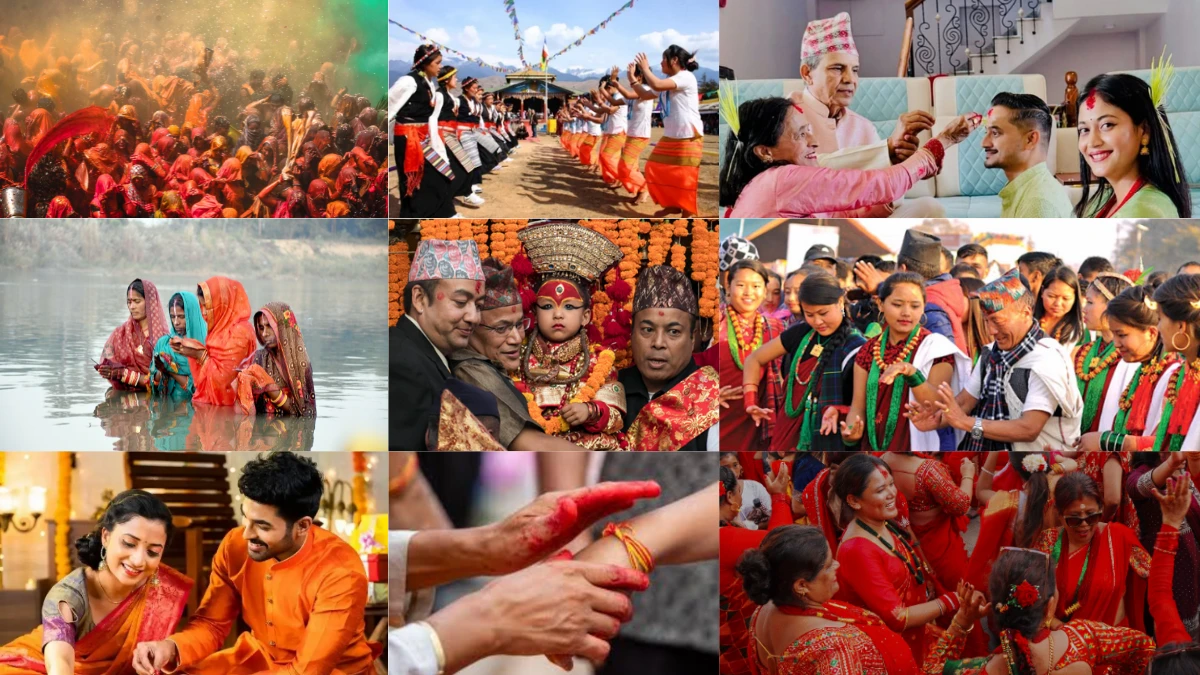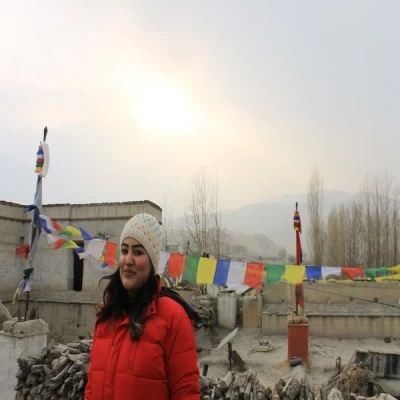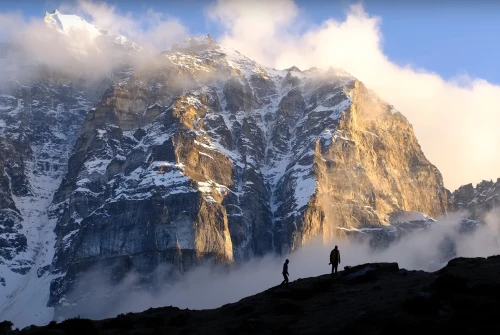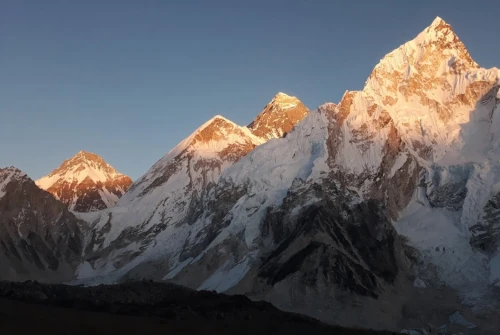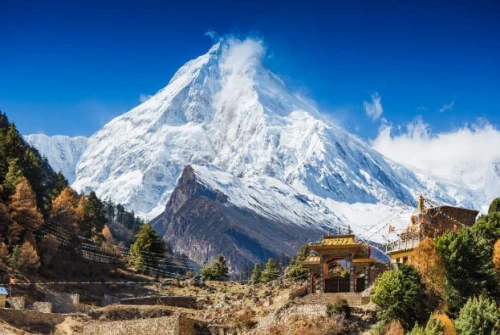Nepal is more than just the home of the Himalayas; it is a vibrant mosaic of cultures, traditions, and celebrations. Across the year, this small yet culturally rich country comes alive with colorful festivals that unite communities, honor deities, and celebrate the changing seasons. Whether it’s the rhythmic beating of drums in Kathmandu’s Durbar Square, the flickering oil lamps of Tihar lighting up the night, or the joyous splashes of color during Holi, Nepal’s festivals offer travelers a chance to witness living traditions in their purest form.
The beauty of Nepal’s festival calendar lies in its diversity. Influenced by Hinduism, Buddhism, and indigenous beliefs, these celebrations vary from grand nationwide events to intimate regional rituals. Each festival carries deep symbolic meaning, from honoring the gods, the natural world, and the cycles of life, to strengthening bonds between families and communities. For a visitor, joining in these festivities is more than just entertainment; it is an invitation to step into centuries-old traditions that are still thriving today.
What makes these celebrations even more special is their timing within the Nepali lunar calendar, meaning each year’s dates shift slightly. Some festivals welcome the harvest, while others mark the New Year; many follow mythological legends of gods, goddesses, and heroes. And while every festival has its unique rituals, they all share a common spirit: joy, togetherness, and gratitude.
In this guide, we take you through Nepal’s major festivals in Nepali calendar order, complete with their 2025 and 2026 dates, cultural background, and what you can expect as a traveler. From the sacred thread-changing ceremony of Janai Purnima to the dazzling lights of Tihar, and from the serene dawn prayers of Chhath to the playful colors of Holi, you’ll discover why Nepal’s festivals are not just events, they are unforgettable experiences that stay with you long after your journey ends.
Maghe Sankranti – The Festival of Longer Days
Date in 2025: January 15, 2025
Date in 2026: January 15, 2026
Maghe Sankranti, celebrated on the first day of the Nepali month of Magh, is one of the few festivals that follow the solar calendar instead of the lunar one. It marks the winter solstice transition, when the sun begins its northward journey (Uttarayan) and days gradually start getting longer. For Nepalis, this shift is symbolic of warmer days ahead, renewed energy, and a season of productivity after the cold winter.
From early morning, devotees take holy dips in rivers such as the Bagmati, Kali Gandaki, or Narayani, believing the ritual washes away sins and brings good health. Families then gather for a hearty meal featuring til ko laddu (sesame seed sweets), chaku (solid molasses), sweet potatoes, yams, and ghee. These foods are considered warming and nourishing for the body in the cold season.
For the Tharu community, this day is called Maghi, their New Year celebration. Villages come alive with dances, music, and big feasts. People visit relatives, strengthen social ties, and make plans for the year ahead. For travelers, visiting the Terai during Maghi offers a warm, hospitable atmosphere with traditional dishes and folk music filling the air.
Teej – The Festival of Women’s Devotion and Joy
Date in 2025: August 26, 2025
Date in 2026: September 14, 2026
Teej is one of the most visually striking and socially vibrant festivals in Nepal, celebrated primarily by Hindu women in honor of Goddess Parvati’s devotion to Lord Shiva. It falls in the month of Bhadra, just after the monsoon rains have freshened the valleys and hills. Teej is not only a religious occasion but also a powerful expression of sisterhood and cultural pride.
The festival spans three days. The day before Teej is known as Dar Khane Din, when women gather at their maternal homes to feast on rich foods such as rice pudding, meat curries, and sweets, a joyful indulgence before the strict fasting. On the main Teej day, women dress in bright red saris, adorn themselves with gold and glass bangles, and visit temples, particularly Pashupatinath Temple in Kathmandu, to pray for the well-being of their husbands or for a good future husband. Many observe a nirjala fast, refraining from both food and water as a display of devotion.
The final day, known as Rishi Panchami, is dedicated to ritual purification, where women bathe with mud and leaves from sacred plants, cleanse themselves in rivers, and perform prayers to seek forgiveness for any sins. For tourists, Teej offers an extraordinary opportunity to witness Kathmandu awash in red, with processions of singing and dancing women filling the streets in an atmosphere of joy and faith.
Indra Jatra – Kathmandu’s Grand Cultural Spectacle
Date in 2025: September 6–11, 2025
Date in 2026: September 25–30, 2026
Indra Jatra, celebrated by the Newar community of Kathmandu, is an eight-day festival dedicated to Indra, the god of rain, and Bhairav, a fierce manifestation of Lord Shiva. It begins in Bhadra/Ashwin, just before the harvest season, and combines religious devotion with dramatic street performances and royal traditions.
The festival starts with the raising of a tall ceremonial pole called the Linga at Basantapur Durbar Square. Throughout the week, Kathmandu’s old city transforms into a living stage with Lakhey masked dances, a display of the sacred mask of Bhairav, and processions of the Kumari, the Living Goddess, who is carried through the streets in an ornate chariot.
Indra Jatra is more than a festival; it is a cultural immersion into Kathmandu’s heritage. Streets are lit with oil lamps, traditional drums beat through the night, and local Newar delicacies are sold on every corner. For visitors, it is an unmissable chance to experience centuries-old rituals blending Hindu and Buddhist traditions, all while surrounded by the architectural wonders of Kathmandu Durbar Square.
Dashain – Nepal’s Greatest Celebration
Date in 2025: September 22 – October 6, 2025
Date in 2026: October 11 – October 25, 2026
Dashain is Nepal’s most important and longest Hindu festival, lasting 15 days and celebrated by people of all ethnicities across the country. It honors Goddess Durga’s victory over the demon Mahishasura, symbolizing the triumph of good over evil, and coincides with the post-monsoon harvest season, making it a time of abundance and family reunions.
The festival begins with Ghatasthapana, when a sacred jar is installed and jamara (barley seeds) are sown in a ritual space. These sprouts are later used as blessings. Over the next days, various forms of Goddess Durga are worshiped, with the most important days being Phulpati, Maha Ashtami, Maha Navami, and Vijaya Dashami. On Vijaya Dashami, elders apply tika (a mixture of rice, vermillion, and yogurt) and jamara to younger relatives’ foreheads, offering blessings for prosperity and protection.
For visitors, Dashain is a beautiful time to see Nepal at its warmest and most festive. Villages set up giant bamboo swings (ping), kites fill the skies, and markets overflow with new clothes and festive foods. Families travel long distances to reunite, and the mood is one of generosity, joy, and deep-rooted tradition.
Tihar – The Festival of Lights and Life
Date in 2025: October 20 – October 24, 2025
Date in 2026: November 8 – November 12, 2026
Tihar, also known as Deepawali or the festival of lights, is Nepal’s second-biggest festival after Dashain. Unlike Dashain’s emphasis on goddess worship and family blessings, Tihar celebrates the relationship between humans, animals, and the gods. It spans five days, with each day dedicated to honoring a specific creature or bond, all while decorating homes with lamps and flowers.
The festival begins with Kaag Tihar, a day for feeding crows, messengers of Yama, the god of death, to avert misfortune. On Kukur Tihar, dogs are honored with garlands, tika, and special treats for their loyalty and guardianship. Gai Tihar celebrates cows, considered sacred and symbols of wealth, while Laxmi Puja on the same evening invites the goddess of prosperity into brightly lit homes.
The final two days are Govardhan Puja and Bhai Tika. Govardhan Puja involves worshiping oxen and building symbolic cow dung mounds representing Mount Govardhan. Bhai Tika is perhaps the most emotional, where sisters place a protective seven-colored tika on their brothers’ foreheads, offering blessings for a long and prosperous life. In return, brothers give gifts and promise to protect their sisters. For travelers, Tihar offers a magical atmosphere, streets glowing with oil lamps, homes decorated with rangoli patterns, and children singing Deusi-Bhailo in every neighborhood.
Chhath – The Sun God Festival
Date in 2025: October 27 – October 30, 2025
Date in 2026: November 15 – November 18, 2026
Chhath is a deeply spiritual Hindu festival primarily celebrated in Nepal’s Terai region and neighboring Indian states. Dedicated to Surya, the Sun God, it is one of the most environmentally conscious festivals, performed to thank the sun for sustaining life and to seek blessings for health and prosperity.
The festival lasts four days and involves strict rituals, including fasting, holy bathing, and offering arghya (water and fruits) to the rising and setting sun. On the first day (Naha Kha), devotees bathe in rivers and prepare pure vegetarian food. The second day (Kharna) involves fasting throughout the day, followed by a single evening meal. The third day is the most important, with devotees standing in rivers or ponds during sunset, holding offerings in bamboo baskets while singing devotional songs. The festival concludes with sunrise prayers on the fourth day.
For tourists, Chhath provides a serene yet powerful visual, thousands of devotees standing in water at dawn and dusk, dressed in bright saris, with the golden reflection of the sun shimmering on the river. It’s a moment of pure devotion and unity with nature.
Maghe Sankranti – The Festival of Winter Renewal
Date in 2025: January 14, 2025
Date in 2026: January 14, 2026
Maghe Sankranti marks the winter solstice according to the Hindu calendar and celebrates the return of longer days. In Nepal, it is a time to eat special warming foods such as til ko laddu (sesame seed sweets), chaku (hardened molasses), and yams, believed to boost immunity during the cold season.
The festival also has religious significance, honoring Lord Vishnu and bathing in sacred rivers like Devghat, Chitwan, and Sankhamul in Kathmandu for purification. In the Tharu community, Maghe Sankranti marks the start of their New Year, celebrated with traditional dances, feasts, and community gatherings.
For travelers visiting Nepal in January, Maghe Sankranti offers a cozy yet culturally rich experience. The smell of sesame sweets fills homes, bonfires keep families warm, and riverside pilgrimages bring together people from all walks of life.
Holi – The Festival of Colors and Joy
Date in 2025: March 13, 2025 (Hilly region) & March 14, 2025 (Terai)
Date in 2026: March 3, 2026 (Hilly region) & March 4, 2026 (Terai)
Holi, celebrated towards the end of winter, is one of the most playful and visually stunning festivals in Nepal. Known as the festival of colors, it welcomes the arrival of spring and celebrates the victory of good over evil, linked to the legend of Prahlad and Holika.
In the hilly regions, Holi is celebrated a day earlier than in the Terai. The festivities begin with the erection of a ceremonial bamboo pole decorated with colorful cloth in Basantapur, Kathmandu. On the main day, people throw colored powders (abir) and water at each other, dance to music, and share festive sweets like gujiya.
For tourists, Holi in Nepal is an unforgettable experience. The streets turn into a sea of colors, strangers greet each other with smiles and splashes of water, and the atmosphere is pure celebration. While Holi is most famously celebrated in Kathmandu, Pokhara, and Terai towns like Janakpur and Birgunj, every part of Nepal has its local charm for the occasion.
Gai Jatra – The Festival of Cows and Remembrance
Date in 2025: August 10, 2025
Date in 2026: August 29, 2026
Gai Jatra, also known as the “Cow Festival,” is one of the most unique and heart-touching celebrations in Nepal, especially in the Kathmandu Valley. Rooted in both humor and remembrance, the festival honors family members who have passed away during the year. According to tradition, it is believed that cows, sacred in Hinduism, help guide the souls of the deceased safely to the afterlife. Families who have lost loved ones lead a cow in a public procession, or if a cow is unavailable, a young boy dressed as one.
The streets during Gai Jatra transform into a lively stage filled with music, dance, and satirical performances. Historically, this was a day when people could openly joke about societal issues without fear, turning grief into laughter and solidarity. For tourists, witnessing Gai Jatra is both moving and fascinating. You’ll see a blend of sorrow, humor, and community spirit that is unlike any other festival in the world. It’s a reminder that even in mourning, the Nepali way is to celebrate life, share compassion, and find strength in togetherness.
Indra Jatra – Kathmandu’s Grandest Street Festival
Date in 2025: September 6–13, 2025
Date in 2026: September 25 – October 2, 2026
Indra Jatra is one of the most spectacular festivals of Kathmandu, combining religious devotion, royal traditions, and vibrant public celebrations. Dedicated to Indra, the Hindu god of rain and the king of heaven, the festival is held to thank him for the life-giving monsoon and to mark the end of the rainy season. Over eight days, the city’s Durbar Square becomes a hub of activity from mask dances and chariot processions to rituals that date back centuries.
One of the highlights is the majestic chariot procession of the Kumari, the Living Goddess of Kathmandu. Pulled through the streets alongside the chariots of the gods Ganesh and Bhairav, this procession draws thousands of spectators. Traditional Lakhe dancers in fearsome masks whirl through the streets, and ceremonial lights illuminate the city. For visitors, Indra Jatra is a once-in-a-lifetime cultural immersion; you are not just watching history; you are standing in the middle of it.
Bisket Jatra – Nepal’s New Year Celebration in Bhaktapur
Date in 2025: April 13–20, 2025
Date in 2026: April 13–20, 2026
Bisket Jatra is the ultimate display of Bhaktapur’s energy and cultural pride, celebrated to mark the Nepali New Year (Bikram Sambat). This week-long event is filled with adrenaline-pumping chariot pulls, street feasts, and rituals that blend mythology with community spirit. The festival’s origins come from a fascinating legend about the defeat of a serpent, symbolizing the victory of good over evil and the start of a fresh year.
The highlight is the massive tug-of-war-style chariot pulling, where locals compete to drag towering wooden chariots of deities Bhairav and Bhadrakali through narrow streets. The excitement is infectious; you’ll feel the ground vibrate under the cheers, drums, and shouts of the crowd. As a tourist, Bisket Jatra offers an unparalleled chance to witness the raw passion of Nepali celebrations and the unity of an ancient city embracing the future.
Lhosar – The Himalayan New Year
Sonam Lhosar (Tamang/Gurung): February 26, 2025 | February 15, 2026
Gyalpo Lhosar (Sherpa): February 28, 2025 | February 17, 2026
Tola Lhosar (Magar): December 30, 2025 | December 18, 2026
Lhosar is the New Year festival celebrated by various Himalayan ethnic groups, each with their traditions and dates. It is a time of renewal, feasting, and honoring ancestors. The Tamang, Gurung, Sherpa, and Magar communities each celebrate Lhosar in their way, but the spirit is the same, welcoming a new cycle with gratitude and joy.
During Lhosar, homes are cleaned and decorated, traditional attire is worn, and families gather to prepare special dishes like khapse (fried pastries) and sel roti. Monasteries hold colorful dances and prayers to ward off negativity for the coming year. For travelers, Lhosar is a chance to see Nepal’s Himalayan cultures in full vibrancy, a joyful blend of music, dance, and community that often includes warmly welcoming guests to join in the feasts.
Conclusion
Experiencing Nepal’s festivals is like stepping into a living story, one where faith, tradition, and community intertwine in a beautiful harmony. These celebrations are not simply dates on a calendar; they are moments when the entire nation, from the bustling streets of Kathmandu to the quiet villages in the mountains, comes together in shared joy. Every festival you witness here is a glimpse into the soul of Nepal, warm, welcoming, and deeply rooted in values that have been passed down through generations.
As a traveler, joining in these festivities offers more than just photographs or souvenirs. It’s the laughter of strangers who treat you like family, the taste of home-cooked meals offered with love, the rhythmic beats of traditional drums that echo through your heart, and the feeling of being part of something timeless. Whether you are lighting a lamp during Tihar, receiving tika in Dashain, dancing in the streets during Indra Jatra, or being covered head to toe in colors during Holi, you’re not just observing, you’re participating in Nepal’s living heritage.
When planning your visit to Nepal, look beyond the mountains and trekking routes. Time your journey to coincide with one of these festivals, and you will return with far more than beautiful memories of landscapes; you will carry with you the heartbeat of Nepal itself. These festivals are not just for the locals; they are an open invitation for the world to celebrate life, faith, and unity the Nepali way.
